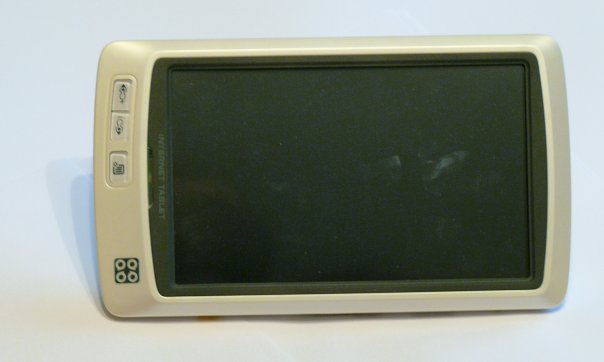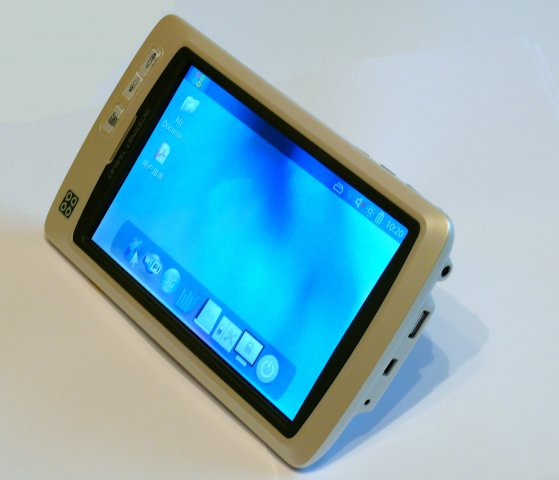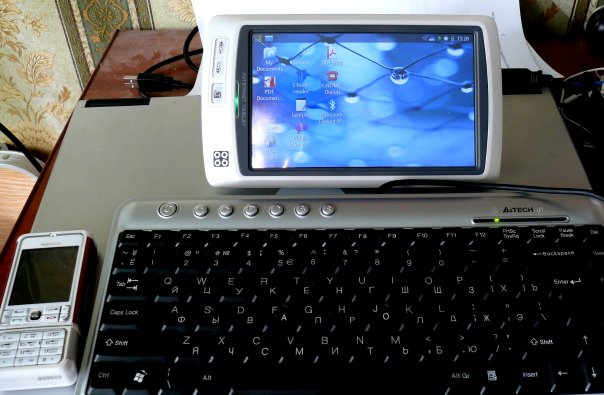Smart Q7 MID Review
I got a new toy - Smart Q7 MID, and I did not find a single review on the Hub, so I’ll tell and show

Processor: Samsung ARM S3C6410 667 MHz
Memory: 128 MB RAM, 1GB ROM
Operating system: Ubuntu Linux (default), WindowsCE (requires license purchase ~ 15 $), Android, Mer
Screen: 7 "800x480 TFT Touch (you can poke your finger, with a fingernail, a stylus, and generally everything you can)
Battery: lithium polymer 4500mAH (enough for about 6-10 hours of active work and about 2 days to listen to music)
Interfaces: USB Host, USB OTG, slot for SD / SDHC cards
Wireless: WiFi, Bluetooth (adapter in USB Host)
Audio: regular 3.5 mm headphone jack, built-in stereo speakers
Weight: about 0.5 kg

Front view of the device itself: left scroll up / down buttons, function button

Side view: headphone input, USB Host, USB OTG, power supply

With a connected keyboard and nokia 3250 for size comparison
I think that it does not make sense to do a detailed review of each program installed by default, the operating system is the usual Ubuntu (April 9 or October 9), so I’ll tell you briefly about the main
things: Internet: Claws Mail, Torrent download, RSS reader, Pidgin, Midori (a pretty smart browser on WebKit engine (the one in Safari), the only negative - there is no Flash support, which means you can’t watch YouTube)
Video player: SMPlayer is a player based on MPlayer, it plays everything that normal MPlayer plays. There is enough processor power to calmly watch a full-length movie in mpeg4 format (xvid, divx, h264, etc.) and a bitrate of about 500-1000 kbps
Audio player: Sonata + MPD
Book reader:FBReader - it’s very convenient to read books, since a device that is half the size of an A4 sheet is almost like a book
Office: AbiWord, Gnumeric and evince (pdf reader, djvu)
Other: notepad (leafpad), organizer (osmo), terminal (where without it ), archiver, dictionary and various system utilities
As the seller promised, it supports USB modems . Easily connected Huawei E160G from the Megaphone-modem kit (described below for firmware version 5):
WiFi connection is even easier:
In order to have something to occupy a USB hole (by the way, it is usual in size, like on any computer), I also bought a keyboard. The result is a netbook with Ubuntu on board - very convenient.
Of course, through USB Host, you can connect everything that has USB, for example, a printer, scanner, modem, mouse, etc.
at the suggestion of rPman, I am starting a series of tests
1. The video rolls in SMplayer (Video: 624x352, 4 fps, XviD, 970 kbps. Audio: 48 kHz, MPEG Layer 3, 2 ch, 128.00 kbps.), backlight and volume at maximum, wifi disabled - played for 5 hours 6 minutes (tested at night, the device turned off at 6:19, turned on at 9 - turned on showed that charging was about 1/3 (via acpi or apm I can’t find out for sure))
2. According to new tests ~ 7 hours of viewing another person’s video turned out, but with a newer and more unofficial firmware
setting up the repository and how to put it on the memory card - I’ll add it on my own - format the card completely and remove Label - otherwise for some reason I didn’t manage to
Russify the virtual keyboard
4 firmware version official source alternative , 5 firmware version official source alternative
transfer of partitions to the memory card so as not to clog the main
keyboard layout (en / ru) switch connected via USB
Build quality, except for the fact that the plug of the SD card is a little crooked, is on top. Nothing creaks and rattles. Plastic looks a little cheap if you look closely, but in general it’s the same as everywhere else
The price for this device ranges from 5 to 10 thousand rubles - it all depends on who and how you order (look at molotok.ru, smartqmid.ru or google). For example, my device came out at about 9k rubles (already bought in Russia).
An alternative review of the device from cCube - I recommend reading it, since the opinion is almost completely opposite
PS: ask questions - what else to test, what do you want to learn more about, etc. - I will update the article

Specifications
Processor: Samsung ARM S3C6410 667 MHz
Memory: 128 MB RAM, 1GB ROM
Operating system: Ubuntu Linux (default), WindowsCE (requires license purchase ~ 15 $), Android, Mer
Screen: 7 "800x480 TFT Touch (you can poke your finger, with a fingernail, a stylus, and generally everything you can)
Battery: lithium polymer 4500mAH (enough for about 6-10 hours of active work and about 2 days to listen to music)
Interfaces: USB Host, USB OTG, slot for SD / SDHC cards
Wireless: WiFi, Bluetooth (adapter in USB Host)
Audio: regular 3.5 mm headphone jack, built-in stereo speakers
Weight: about 0.5 kg
Appearance

Front view of the device itself: left scroll up / down buttons, function button

Side view: headphone input, USB Host, USB OTG, power supply

With a connected keyboard and nokia 3250 for size comparison
Software included
I think that it does not make sense to do a detailed review of each program installed by default, the operating system is the usual Ubuntu (April 9 or October 9), so I’ll tell you briefly about the main
things: Internet: Claws Mail, Torrent download, RSS reader, Pidgin, Midori (a pretty smart browser on WebKit engine (the one in Safari), the only negative - there is no Flash support, which means you can’t watch YouTube)
Video player: SMPlayer is a player based on MPlayer, it plays everything that normal MPlayer plays. There is enough processor power to calmly watch a full-length movie in mpeg4 format (xvid, divx, h264, etc.) and a bitrate of about 500-1000 kbps
Audio player: Sonata + MPD
Book reader:FBReader - it’s very convenient to read books, since a device that is half the size of an A4 sheet is almost like a book
Office: AbiWord, Gnumeric and evince (pdf reader, djvu)
Other: notepad (leafpad), organizer (osmo), terminal (where without it ), archiver, dictionary and various system utilities
Internet connection
As the seller promised, it supports USB modems . Easily connected Huawei E160G from the Megaphone-modem kit (described below for firmware version 5):
- We insert the modem and click on the 3G icon on the screen
- In the list that appears, select GPRS / EDGE, Gnome-ppp opens, click Setup
- In the settings, click "Detect" - the modem will be on / dev / ttyUSB0, set the maximum speed
- Click the “Init String” button and fix the second line to AT + CGDCONT = 1, “IP”, “internet” (for a megaphone)
- Scroll the window to the bottom (press the button on the left in the center and drag the window - like Alt + drag and drop with the mouse) and click "Close"
- In the username and password fields we hammer internet
- Click "Connect" and wait for it to connect
WiFi connection is even easier:
- Press the WiFi button on the screen or on the WiFi icon in the tray
- Choose the WiFi access point we need, click "Connect"
- We enter the necessary data if the point, for example, is password protected and enjoy
USB host
In order to have something to occupy a USB hole (by the way, it is usual in size, like on any computer), I also bought a keyboard. The result is a netbook with Ubuntu on board - very convenient.
Of course, through USB Host, you can connect everything that has USB, for example, a printer, scanner, modem, mouse, etc.
Battery life
at the suggestion of rPman, I am starting a series of tests
1. The video rolls in SMplayer (Video: 624x352, 4 fps, XviD, 970 kbps. Audio: 48 kHz, MPEG Layer 3, 2 ch, 128.00 kbps.), backlight and volume at maximum, wifi disabled - played for 5 hours 6 minutes (tested at night, the device turned off at 6:19, turned on at 9 - turned on showed that charging was about 1/3 (via acpi or apm I can’t find out for sure))
2. According to new tests ~ 7 hours of viewing another person’s video turned out, but with a newer and more unofficial firmware
Useful links for owners
setting up the repository and how to put it on the memory card - I’ll add it on my own - format the card completely and remove Label - otherwise for some reason I didn’t manage to
Russify the virtual keyboard
4 firmware version official source alternative , 5 firmware version official source alternative
transfer of partitions to the memory card so as not to clog the main
keyboard layout (en / ru) switch connected via USB
Build quality
Build quality, except for the fact that the plug of the SD card is a little crooked, is on top. Nothing creaks and rattles. Plastic looks a little cheap if you look closely, but in general it’s the same as everywhere else
Devices that were able to connect
- mouse and keyboard
- USB flash drives and HDD
- Huawei E160G - from the Megafon Modem Kit
- Mustek BearPaw 2400 CU Plus scanner (works well and does not require additional power, so the device’s USB port honestly gives 5V and 500 mA)
- HP 1020 Printer
Issue price
The price for this device ranges from 5 to 10 thousand rubles - it all depends on who and how you order (look at molotok.ru, smartqmid.ru or google). For example, my device came out at about 9k rubles (already bought in Russia).
An alternative review of the device from cCube - I recommend reading it, since the opinion is almost completely opposite
PS: ask questions - what else to test, what do you want to learn more about, etc. - I will update the article
